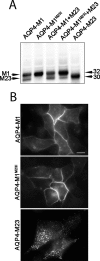Evidences for a leaky scanning mechanism for the synthesis of the shorter M23 protein isoform of aquaporin-4: implication in orthogonal array formation and neuromyelitis optica antibody interaction
- PMID: 20007705
- PMCID: PMC2836061
- DOI: 10.1074/jbc.M109.069245
Evidences for a leaky scanning mechanism for the synthesis of the shorter M23 protein isoform of aquaporin-4: implication in orthogonal array formation and neuromyelitis optica antibody interaction
Abstract
Aquaporin-4 (AQP4) exists as two major isoforms that differ in the length of the N terminus, the shorter AQP4-M23 and the longer AQP4-M1. Both isoforms form tetramers, which can further aggregate in the plasma membrane to form typical orthogonal arrays of particles (OAPs) whose dimension depends on the ratio of the M1 and M23. In this study, we tested the hypothesis that the M23 isoform can be produced directly by the M1 mRNA. In cells transiently transfected with AQP4-M1 coding sequence we observed besides AQP4-M1 the additional presence of the AQP4-M23 isoform associated with the formation of typical OAPs observable by two-dimensional blue native/SDS-PAGE and total internal reflection microscopy. The mutation of the second in-frame methionine M23 in AQP4-M1 (AQP4-M1(M23I)) prevented the expression of the M23 isoform and the formation of OAPs. We propose "leaky scanning" as a translational mechanism for the expression of AQP4-M23 protein isoform and that the formation of OAPs may occur even in the absence of AQP4-M23 mRNA. This mechanism can have important pathophysiological implications for the cell regulation of the M1/M23 ratio and thus OAP size. In this study we also provide evidence that AQP4-M1 is mobile in the plasma membrane, that it is inserted and not excluded into immobile OAPs, and that it is an important determinant of OAP structure and size.
Figures





Similar articles
-
Model of aquaporin-4 supramolecular assembly in orthogonal arrays based on heterotetrameric association of M1-M23 isoforms.Biophys J. 2011 Jun 22;100(12):2936-45. doi: 10.1016/j.bpj.2011.05.012. Biophys J. 2011. PMID: 21689527 Free PMC article.
-
Live cell analysis of aquaporin-4 m1/m23 interactions and regulated orthogonal array assembly in glial cells.J Biol Chem. 2009 Dec 18;284(51):35850-60. doi: 10.1074/jbc.M109.071670. J Biol Chem. 2009. PMID: 19843522 Free PMC article.
-
Super-resolution imaging of aquaporin-4 orthogonal arrays of particles in cell membranes.J Cell Sci. 2012 Sep 15;125(Pt 18):4405-12. doi: 10.1242/jcs.109603. Epub 2012 Jun 20. J Cell Sci. 2012. PMID: 22718347 Free PMC article.
-
Live-cell imaging of aquaporin-4 diffusion and interactions in orthogonal arrays of particles.Neuroscience. 2010 Jul 28;168(4):892-902. doi: 10.1016/j.neuroscience.2009.08.034. Epub 2009 Aug 20. Neuroscience. 2010. PMID: 19699275 Free PMC article. Review.
-
Live-cell imaging of aquaporin-4 supramolecular assembly and diffusion.Methods Enzymol. 2012;504:341-54. doi: 10.1016/B978-0-12-391857-4.00017-3. Methods Enzymol. 2012. PMID: 22264543 Free PMC article. Review.
Cited by
-
Development of an Aquaporin-4 Orthogonal Array of Particle-Based ELISA for Neuromyelitis Optica Autoantibodies Detection.PLoS One. 2015 Nov 24;10(11):e0143679. doi: 10.1371/journal.pone.0143679. eCollection 2015. PLoS One. 2015. PMID: 26599905 Free PMC article.
-
Regulation of aquaporin-4 expression in the central nervous system investigated using M23-AQP4 null mouse.Glia. 2021 Sep;69(9):2235-2251. doi: 10.1002/glia.24032. Epub 2021 May 26. Glia. 2021. PMID: 34038017 Free PMC article.
-
Identification of alternatively translated Tetherin isoforms with differing antiviral and signaling activities.PLoS Pathog. 2012 Sep;8(9):e1002931. doi: 10.1371/journal.ppat.1002931. Epub 2012 Sep 27. PLoS Pathog. 2012. PMID: 23028328 Free PMC article.
-
A novel human aquaporin-4 splice variant exhibits a dominant-negative activity: a new mechanism to regulate water permeability.Mol Biol Cell. 2014 Feb;25(4):470-80. doi: 10.1091/mbc.E13-06-0331. Epub 2013 Dec 19. Mol Biol Cell. 2014. PMID: 24356448 Free PMC article.
-
Association Between the Single Nucleotide Polymorphism and the Level of Aquaporin-4 Protein Expression in Han and Minority Chinese with Inflammatory Demyelinating Diseases of the Central Nervous System.Mol Neurobiol. 2016 Jul;53(5):2878-2885. doi: 10.1007/s12035-015-9171-9. Epub 2015 Apr 18. Mol Neurobiol. 2016. PMID: 25895050
References
-
- Frigeri A., Gropper M. A., Umenishi F., Kawashima M., Brown D., Verkman A. S. (1995) J. Cell Sci. 108, 2993–3002 - PubMed
-
- Verkman A. S., Binder D. K., Bloch O., Auguste K., Papadopoulos M. C. (2006) Biochim. Biophys. Acta 1758, 1085–1093 - PubMed
-
- Amiry-Moghaddam M., Ottersen O. P. (2003) Nat. Rev. Neurosci. 4, 991–1001 - PubMed
Publication types
MeSH terms
Substances
LinkOut - more resources
Full Text Sources
Molecular Biology Databases

